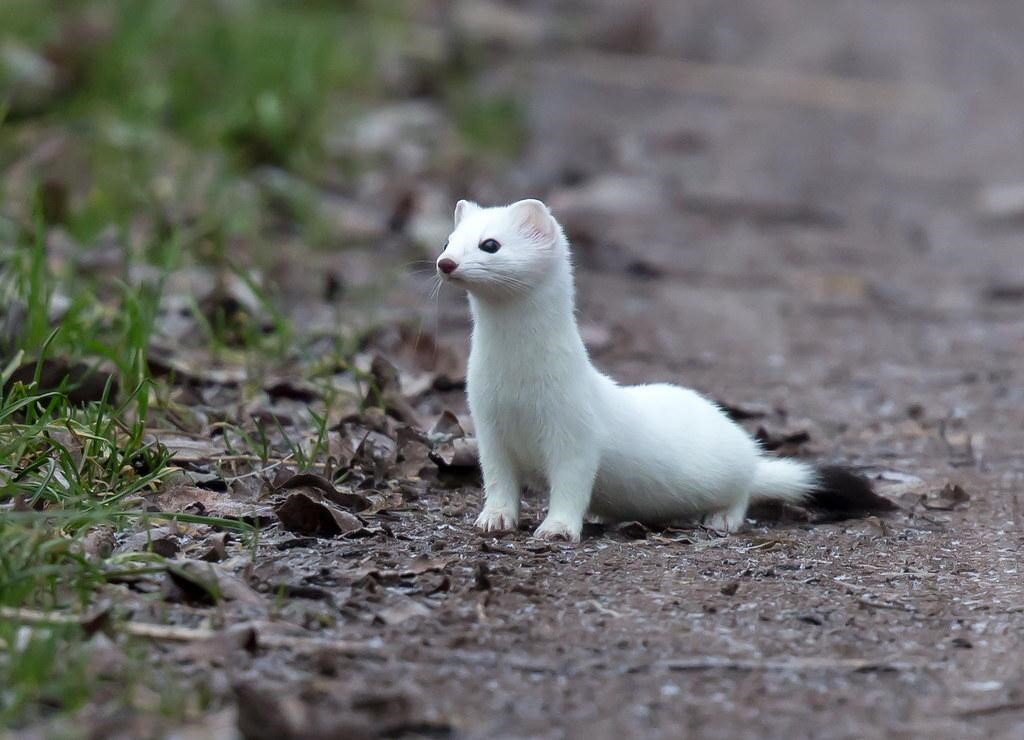Ermine Fact Sheet
Also known as the short-tailed weasel or stoat, the ermine is Alaska’s cute, color-changing weasel. Weighing just under half a pound, these lightweights may be one of the best pound-for-pound predators in Alaska, occasionally taking down rabbits twice their size.
They are a highly adaptable species and can be found in nearly every corner of Alaska. Look for their brownish red fur in the summer and pure white fur in the winter!
Some of the current threats to the ermine include:
Decreasing prey populations
Trapping
Changes in habitat due to clear-cut logging and increased wildfires
DID YOU KNOW…
The ermine changes its fur color from a reddish-brown to a stark white as summer turns into winter
Ermine will sometimes hunt large prey like shrews and rabbits, rabbits being about twice the ermine’s size
Female ermine are smaller than the male and will use their size to fit perfectly into vole tunnels, the ermine’s preferred prey
Ermine will often dig a special storage area in their dens for excess food
SCIENTIFIC AND COMMON NAMES
Mustela erminea – Ermine; Stoat; Short-Tailed Weasel; Known as Tibiaq and Itibiaq in Inupiat; Enairayuliyagaq in Yupik; Daa in Tlingit
GENERAL DESCRIPTION
The ermine looks a lot like a typical weasel, with its long body, short legs, and long neck. It’s known as the short-tailed weasel because it has a much shorter tail than its longer tailed cousin, which is aptly named - you guessed it- the long-tailed weasel.
They look nearly identical, with both species having reddish-brown fur on top of a white underbelly in the summer and stark white fur in the winter. They make this change so they can disappear in the snow, which makes it much easier to both hunt prey and avoid predators. The tip of their tail will remain a dark black during all seasons.
Ermine are a bit smaller than the longer tailed cousins, coming in at less than a pound and around 13 inches in length. Their tails are around a third of that length and actually aren’t that short compared to their own bodies. Females tend to be around 50% smaller than males, and they use that size to enter the homes of small prey.
Get up close to an ermine with Brave Wilderness at a wildlife sanctuary in Haines, Alaska...
RANGE
The ermine lives all over Alaska, from the mainland to islands in Southcentral and some parts of the Southeast. Some reports show ermine living on Evans Island, Prince William Sound, and possibly other islands in Prince William Sound. The genetic characteristics of ermine in these locations may even be distinctive.
Ermine are well adapted to different habitats. It prefers wooded areas near streams and often lives at forest-edge habitats, wet meadows, marshes, ditches, river woodlands, or riverbanks with lots of small mammals and foraging space. Coastal ermine may prefer lower elevated habitats near water.
Males generally occupy a wider range of habitats than females and both males and females occupy a wider variety of habitat types during spring and summer than during fall and winter.
They are well-adapted to snowy environments and range into alpine areas. They have been documented year-round living at 2,000–3,000 ft in the Sierra Nevada, California, and commonly live in tundra habitats throughout northern Canada and Alaska.
Watch how an Ermine in the UK change from brown to white...
THREATS/CONCERNS
Ermine are hunted regularly for their pelts, which are often used to trim coats and other clothing. Due to the ermine’s small size, they also oftentimes get caught in traps meant for other small species.
Additionally, clear-cut logging poses a threat to the ermine’s preferred home. These areas are often already affected by wildfires, making regrowth of these areas even less successful.
Another key threat are changes in prey populations. Ermine prefer smaller prey like voles, which are a favorite among many other predators like foxes and owls. Shifts in climate have also forced new species to move into some areas that ermine call home, causing even more competition for an already in-demand food source.
LIFE HISTORY
Ermine mate in late spring to early summer. Females are sexually mature at three to four months, while males likely reach sexual maturity at 12 months. Females may survive for at least 2 breeding seasons while males typically only last 1. Their reproductive success is highly dependent on food availability.
After a 4-week gestation period, one litter of four to 13 (average of six) young is usually born in either April or May. Females care for the young alone and will lactate until seven to 12 weeks. Young ermine will begin exploring outside of the nest at just six to eight weeks.
The nest is usually a former burrow of a small rodent and typically lined with rodent hair. It may also be in a rock pile, hollow log, or underbrush piles or trees. For ermine further north, snow provides vital insulation against extreme air temperatures.
Check out this video of an ermine in Alaska!
DIET
Ermine are carnivores that mainly eat small mammals like voles and mice. They will occasionally eat shrews and rabbits and other small vertebrates and insects. Some ermine will also eat small fish from nearby rivers.
Ermine are particularly well-adapted to northern environments because they can enter small tunnels in the snow that were formed by small prey like their preferred prey, voles.
Weasels in general are also scavengers. Ermine are opportunistic animals who have been seen eating large catches from other predators like wolves and bears.
Watch the Ermine hunt for prey twice its size!
ERMINE COLORING SHEET
Check out our Facebook or Twitter to learn more about Alaska wildlife! If you haven’t already, subscribe to our free newsletter to learn more about Alaska Wildlife Alliance. If you’re interested in supporting wildlife conservation in Alaska, become a member for as little as $35 per year.
Information obtained from: Alaska Department of Fish and Game, Alaska Magazine, Alaska Guide, and University of Michigan.



